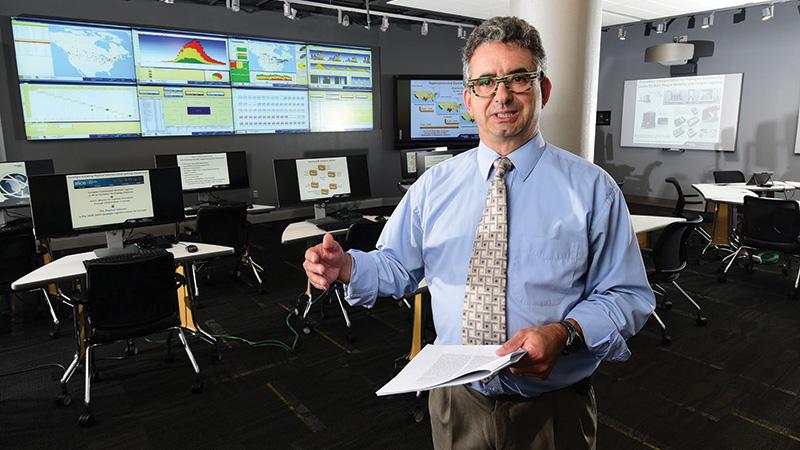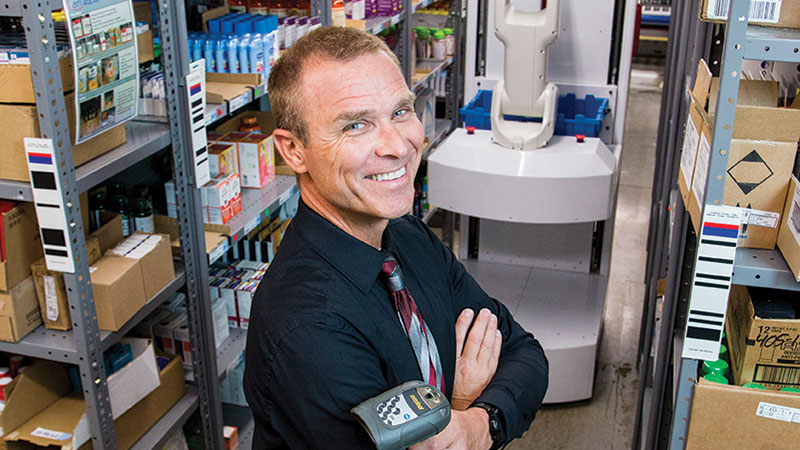We all like to talk about the rapid rate of change. People said it 100 years ago, and we’re still at it, usually claiming that the current rate of change is unprecedented. Whether that’s true is not really the point anymore. Instead, change is now indisputably a constant state. And, we all better be coping with it.
This month’s Big Picture offers five glimpses into what specifically is changing. The comments here range from new designs and operational modes for warehouses to a completely new supply chain model called the Physical Internet. Then, there’s mobility and wearables as well as mobile piece-picking robots. Not to mention the elephant in the room—sustainability.
As you will realize, it’s now time to focus just as much on the foreseeable future as it is to pick, pack and ship today’s orders.
John A. White III, president and CEO at Fortna
On the impact of change in the DC

You don’t have to go back more than five or seven years to see the big shift in the DC and warehouse. Back then, a warehouse manager knew what demand levels would be for the next day and could plan accordingly. Now, it’s a constant flow of new orders throughout the day, especially in e-commerce.
That means that the work is harder to plan and execute because everything is dynamic. That shift is enormous. It has an impact on order cycle times, timely access to SKUs, consolidation of order lines, efficient use of labor and workflow, to name just a few key metrics. There’s also the matter of equipment and labor optimization. The result is much greater complexity on the floor, and that requires completely different facility designs and modes of operation.
The challenge now and going forward is to design and implement systems to continuously optimize as conditions change throughout the day. I’m not talking about managers making these decisions as they do today. I’m talking about systems making recommendations to managers or even making the actual decisions without human input in many cases. Decision science and optimization is the future.
This change requires a new approach to facility design. Companies like Fortna approach design differently, extending from equipment selection and integration to workflow optimization. Software, especially warehouse execution systems, play an increasingly prominent role in doing all of this in real time. It comes down to optimizing workflow, labor and equipment to meet customer expectations and do it more efficiently than ever.
Walmart and Amazon can afford to develop these capabilities internally. Other companies’ primary focus is on getting orders out the door. They need to bring knowledge, expertise and innovation from the outside to help them apply technologies and systems that optimize operations. We believe companies need to have a program in place that provides 10% classroom training, 20% coaching and mentoring and 70% experience-based learning.
People have to be life-long students who continuously improve. The future of distribution depends on developing a talent pool that can apply decision science and technology to the challenges of real-time optimization.
Benoit Montreuil, Coca-Cola material handling and distribution chair and professor at Georgia Tech
On the Physical Internet

It all started as a headline in the Economist in 2006. I picked up a copy at the airport on a trip back to America. The idea of a Physical Internet sounded interesting. Unfortunately, the articles never explained what a Physical Internet would be.
But the idea was so interesting to me that I spent the next six months coming up with my own definition. The Physical Internet (PI) is the supply chain’s metaphor for the Information Internet. Quite simply, the Physical Internet is a ubiquitous handling and logistics system for moving and deploying goods through the supply chain. It’s a true open network of logistics networks.
The concept is not a whole lot different than the Information Internet’s movement and management of standard data packets around the world. Today, nothing is standard about moving goods at any stage of
the supply chain except for maritime containers. The Physical Internet changes all that. It starts with standardized modular packaging, moves up to small modular handling containers and on to modular transport containers. It’s a lot like a combination of Lego blocks and Russian dolls.
But, it doesn’t stop there. The Physical Internet is also a meshed multi-party network of hyperconnected facilities that crossdock and store goods through the supply chain. It’s a continuous-flow, multimodal logistics model with a network of open hubs on one side and of open distribution and fulfillment centers on the other side. Open hubs aren’t many days of driving distant from each other.
In long-haul transportation, they are 100 or 200 miles apart. Drivers drop their standard modular transport containers at a hub for another driver to take the next leg. Then, the original driver can pick up a different load and return it to that morning’s home base. In urban omni-channel logistics, open intra-city hubs span the city, a few miles away, allowing them to crossdock handling and packaging containers from open peri-urban hubs and fulfillment centers toward their final destination, or vice-versa, exploiting green vehicles fitted to urban settings.
In the beginning, the Physical Internet lived primarily in academic research. While that work continues, industry is now leading the way in the United States, Europe and Asia with a flow of innovative hyperconnected solutions, technologies and business models. Around the world, industry probably has tens of explicit PI projects underway. And, hundreds incorporate aspects of PI.
For example, take a close look at the Amazon fulfillment model and it’s easy to see key aspects of the Physical Internet. Its fulfillment centers are open to any vendor in the same way Amazon offers Cloud computing and storage services. This enables vendors to deploy their products to ensure fast delivery all across the country without investing in facility assets.
In Europe, an organization called ALICE—Alliance for Logistics Innovation through Collaboration in Europe—is a EU-funded European technology platform charged with developing a strategy for supply chains and logistics systems on the continent. It has made the PI the heart of its European strategic vision. Numerous millions European Union and businesses are working to make PI-based networks a widespread reality by 2030. That’s a long way from a headline in the Economist.
Gary Ritzmann, project manager at Rochester Drug
On mobile piece-picking robots

Last fall, Modern Materials Handling introduced Adam to the world. Rochester Drug. Now, this isn’t a science experiment—Adam picks more than 100 items an hour, just like the people in our DC.
But, we are going slowly with the project. When we started out, many of us, myself included, expected to have multiple robots on the floor in six months. Well, we’re past six months, and we’ve still got
only one on the floor. It is a second robot while Adam is back at IAM Robotics being upgraded. It’s not that the technology isn’t working well. It is. It just takes more time and effort than we originally expected. Let me explain.
At Rochester Drug, we know we are well ahead of the curve of mobile piece-picking robots moving into DCs. But, it’s not by much. I fully expect that within two or three years, the technology will start to take
off. After all, materials handling suppliers of all sizes are pursuing mobile robots. And, the labor market for DCs certainly isn’t getting any bigger.
But to get there, several aspects have to be worked out. To start, there has to be a strong ROI. This is not the 1980s when so many CEOs wanted robots in their facilities for the cool factor. Mobile piecepicking robots are way past just being cool. Furthermore, the technology is still developing. You can’t expect a piece-picking robot to handle items just like a human.
You will have to make some adjustments as we discussed in the article. We also underestimated one other aspect. These robots do have to be integrated into your operations. But, it is even more important to integrate them into your culture. We did not do enough initially in retrospect.
We made it clear to all that no one would lose a job. Everyone affected by the robot will move to a position that will make them personally more valuable to the company. We figure each robot will free up 1.5 employees for other activities. That said, some people are still resistant. For real success here, everyone has to buy into the move to mobile robots.
The technology has to become a real part of the culture. Otherwise, your chances of meeting the calculated ROI are not what they should be. We continue to work on making robots part of our culture. We have to, or we won’t be successful.
David Krebs, vice president of research, and Spencer Gisser, researcher at VDC Research
on mobility and wearables

Mobility and wearables are now ready to break out in facilities of all sizes. We call this the fifth wave in the evolution of these technologies. It started with the standardization of WLAN with the ratification of 802.11b followed by Windows and Palm operating systems establishing themselves on handheld computers and PDAs.
Then RIM brought wireless e-mail to the masses, becoming the catalyst for the third wave followed by the iPhone and multi-touch user interfaces driving the fourth. This fifth wave is about natural interfaces—especially conversational voice—and its impact on the design of next generation wearable mobile devices.
In addition, from a data and application perspective, we are seeing the continued breaking down of informational siloes and through investments in Cloud infrastructure and API services,
seamless access to the right information at the right place and time is becoming a reality. This fifth wave will also witness the early benefits of AI and machine learning, truly harnessing the benefits of big data.
One challenge will be the ability to avoid coding in our own biases that could become increasingly difficult to undo. Data democratization and the ability to weave together critical data from disparate sources will improve workflows and bring greater efficiencies. Furthermore, the devices themselves will increasingly enable the workforce in a much less intrusive and more natural way, improving worker satisfaction and, in some cases, even worker safety.
We think mobile devices are finally in a position to eliminate pain points and pinch points, rather than just develop a workaround that results in incremental improvements. The devices themselves are changing, too. We have witnessed a massive shift from legacy—text and keyboard-centric—mobile solutions to enterprise-oriented devices that mimic the design and user interfaces common in consumer devices while still offering support services critical to the enterprise customer.
Wearable solutions are also at a crossroads with the advent of functional smart glasses and heads-up displays freeing the hands of many mobile workers. The result is a huge opportunity to digitize the workflow in facilities across many industries, as they all face strong challenges that undercut not just efficiency but profitability. The need for greater operational efficiencies and visibility is challenging organizations across most sectors from CPG and retail distribution to industrial manufacturing and energy services.
Clearly, mobility and wearables are past the stage of emerging technologies. They are the next wave of technology to digitize operational workflows with a strong dose of easy-to-use, integrated information systems.
John Davies, vice president and senior analyst at Green Biz Group
On sustainability within the four walls

In the past 10 years, the lens we use to look at sustainability within the four walls has changed considerably. Before, sustainability was considered a good idea, but was often too expensive to pursue. Today, we know sustainability is a necessity that is financially viable and able to deliver new efficiencies to facilities. I’ll start with solar power for DCs. Today, solar in many parts of the country is at least competitive with traditional energy including natural gas. Prologis is the solar leader for DCs.
According to Prologis’ vice president of sustainability Jeannie Renne-Malone, the company has a total solar footprint of 175 megawatts, or MW, of generating capacity in nine countries. She says that equates to clean power for 26,000 average homes a year. In terms of commercial use of solar in the United States, other leaders include Target, Walmart, and several other retailers, according to the Solar Energy Industries Association.
While Prologis’ solar is all in DCs, my estimate is that about 15% of solar at the retail leaders is in DCs. The balance is at their stores. It’s also worth mentioning that Apple and Amazon are in the Top 10. To help put what Prologis has done in perspective, Target is the overall leader in solar power on that list. It has 204 MW total of installed solar capacity. So I’d estimate that about 30 MW is at its DCs.
Even wind power is becoming part of the discussion on sustainable energy for DCs. Unlike solar, wind energy is typically fed into the grid from wind farms. But interest is developing in local wind power collection that is stored in special batteries on site. Lighting retrofits are another big opportunity for sustainability within the four walls. Not only is LED (light emitting diode) lighting more efficient, but it is better lighting, improving the work environment for associates.
It’s all part of the movement to making DCs, and other buildings for that matter, healthier to work in.
Article topics
Email Sign Up
















